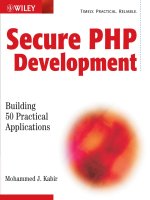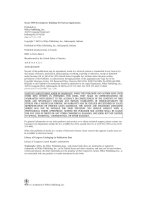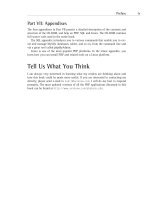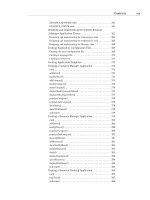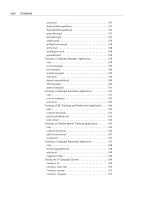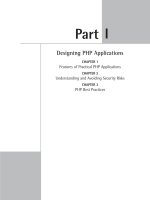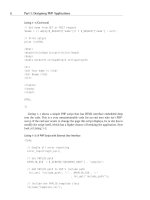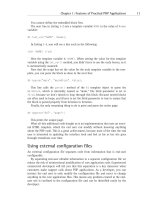Secure PHP Development- P60 ppsx
Bạn đang xem bản rút gọn của tài liệu. Xem và tải ngay bản đầy đủ của tài liệu tại đây (99.7 KB, 5 trang )
| |
+ ld_tools (Intranet Simple Document Publisher Application) |
| |
+ apps (publisher apps and configuration files) |
| |
+ class (publisher apps and configuration) |
| |
+ templates (publisher HTML templates) |
| |
+ themes symbolically linked +
By changing the following configuration parameters in ld.conf, you can mod-
ify the directory structure to fit your site requirements.
$ROOT_PATH = $_SERVER[‘DOCUMENT_ROOT’];
$REL_PHOTO_DIR = ‘/photos’;
$PHOTO_DIR = $ROOT_PATH . $REL_PHOTO_DIR;
$REL_ROOT_PATH = ‘/ld_tool’;
$REL_APP_PATH = $REL_ROOT_PATH . ‘/apps’;
$TEMPLATE_DIR = $ROOT_PATH . $REL_APP_PATH . ‘/templates’;
$CLASS_DIR = $ROOT_PATH . $REL_APP_PATH . ‘/class’;
$REL_TEMPLATE_DIR = $REL_APP_PATH . ‘/templates/’;
$THEME_TEMPLATE_DIR = $TEMPLATE_DIR . ‘/themes’;
The themes directory within the ld_tools/apps/templates should be a symbolic link
pointing to the themes directory of the Intranet home application themes. For the
given directory structure the ld_tools/apps/templates/themes can be created using
the following command:
ln -s home/templates/themes ld_tools/apps/templates/themes
The above command assumes that it is being run from the %DocumentRoot%
(htdocs) directory of the intranet Web site. If you cannot make symbolic links
between two directories, you can simply copy the home/templates/themes directory
as ld_tools/apps/templates/themes. Also, you can set the $THEME_TEMPLATE_DIR to
$ROOT_PATH . ‘/home/templates/themes’
.
The messages file
The messages displayed by the publisher applications are stored in the
ch8/apps/ld.messages file in the CDROM. You can change the messages using a
text editor.
266 Part II: Developing Intranet Solutions
11 549669 ch08.qxd 4/4/03 9:25 AM Page 266
The errors file
The error messages displayed by the document publishing applications are stored in
the ch8/apps/ld.errors file in the CDROM. You can modify the error messages
using a text editor.
Setting Up the Application
Templates
The HTML interface templates needed for the applications are included on the
CD-ROM. These templates contain various template tags to display necessary infor-
mation dynamically. The templates are named in the ld.conf file. These templates
are discussed in Table 8-3.
TABLE 8-3 HTML TEMPLATES
Configuration Variable Template File Purpose
$STATUS_TEMPLATE ld_status.html Shows status
message.
$LD_HOME_TEMPLATE ld_brief.html Document index
template.
$LD_DETAILS_TEMPLATE ld_details.html Shows the contents of
the document.
$LD_RESPONSE_TEMPLATE ld_response_ Web form template to
input.html enter response
information.
$LD_VIEW_RESPONSE_TEMPLATE ld_response_ Response viewer
view.html template.
$ADD_MOD_DOC_TEMPLATE ld_add_mod_doc.html Web form template to
add or modify
documents.
$ADD_MOD_CATEGORY_TEMPLATE ld_add_mod_cat.html Web form template to
add or modify
category.
Continued
Chapter 8: Intranet Simple Document Publisher 267
11 549669 ch08.qxd 4/4/03 9:25 AM Page 267
TABLE 8-3 HTML TEMPLATES (Continued)
Configuration Variable Template File Purpose
$ANNOUNCE_LD_ADDED_TEMPLATE ld_added_ Message template
announcement.html is shown when a new
document is added.
$ANNOUNCE_LD_MOD_TEMPLATE ld_modified_ Message that is
announcement.html shown when an
existing document is
modified.
$LD_VISIT_LIST_TEMPLATE ld_visit_list.html Lists the complete
document-tracking
information.
$LD_REORDER_CAT_TEMPLATE ld_order_cat.html Web form template
that enables an
administrator to
modify the order of
the categories.
The Document Publisher Application
The document publisher application, ld_admin_mngr.php, is responsible for man-
aging documents and categories. This application is included on the CD-ROM in the
ch8/apps directory.
It implements the following functionality:
◆
Enables administrative users to create, modify, and delete categories and
documents.
◆
Enables administrative users to assign viewers (users who can view docu-
ments in a category) and publishers (users who can create, modify, or
delete documents in a category) to each category.
◆
Enables users to create, modify, and delete documents.
◆
Does not allow non-administrative users to create, modify, or delete
categories.
The
ch8/apps/ld_admin_mngr.php in the CDROM an implementation of this
application.
268 Part II: Developing Intranet Solutions
11 549669 ch08.qxd 4/4/03 9:25 AM Page 268
Here are the methods in this application:
◆
run(): When the application is run, this method is called. It decides which
functionality is requested by the user and calls the appropriate driver
method to perform the desired operations. Here’s how it works:
■
Creates a theme object, $this->themeObj.
■
The current user’s theme choice is stored in $this->theme by calling
the getUserTheme() method of the theme object created.
■
If the application is called with the cmd=del query parameter,
deleteDriver() is run. Similarly, cmd=add calls addDriver(),
cmd=mod calls modifyDriver(), and cmd=reo calls reorderDriver().
◆
reorderDriver(): This method is used to change the order of the cate-
gories in the system. Categories can be displayed in navigation displayed by
the home.php (discussed in Chapter 7) in the given order set by this method.
In addition, when the categories are listed in the document index page,
the order of each category is determined by order information stored in
the database. This method allows you to change the order. It is called
when cmd=reo is passed as a query parameter to the application.
Here is how it works:
■
The method checks to see if the application is being run by an adminis-
trator. If it isn’t, the method returns a null.
■
The reordering of categories requires that first the user is given a chance
to set the order and then apply the requested order. So the method uses
the $step query parameter to control the application state.
■
If step=1 is passed, the method displays the Web form that allows the
user to reorder the categories. This Web form is created by calling
displayReorderMenu(). If step=2 is passed, the method updates the
order of the category because the step=2 is only passed from the Web
form displayed by displayReorderMenu(), which is shown when
step=1 is passed.
◆
deleteDriver(): This method controls how delete operations are per-
formed on documents, responses, and categories. It works as follows:
■
If the obj=doc query parameter is passed to this method when called, it
calls deleteDoc() to start the document delete process.
■
If the obj=response query parameter is passed, it runs
deleteResponse() to start the delete process for response for a
document.
■
If the obj=category query parameter is passed, it runs
deleteCategory() to start the category delete process.
Chapter 8: Intranet Simple Document Publisher 269
11 549669 ch08.qxd 4/4/03 9:25 AM Page 269
◆
addDriver(): This method controls how add operations are performed on
documents and categories. It works as follows:
■
If the obj=doc query parameter is passed to this method when called, it
calls addDoc() to start the document creation process.
■
If the obj=category query parameter is passed, it runs addCategory()
to start the category creation process.
◆
modifyDriver(): This method controls how modify operations are per-
formed on documents and categories. It works as follows:
■
If the obj=doc query parameter is passed to this method when called, it
calls modifyDoc() to start the document modification process.
■
If the obj=category query parameter is passed, it runs
modifyCategory() to start the category modification process.
◆
addDoc(): This method controls how a new document is added. It works
as follows:
■
If the step=NULL query parameter is passed, it calls the
displayAddModDocMenu() method with ‘add’ parameter to display the
new document Web form.
■
If the step=2 query parameter is passed, storeDoc() is called to store
the new document.
◆
modifyDoc(): This method controls how documents are modified. It
works as follows:
■
If the step=NULL and nid (document ID) query parameter is not empty,
displayAddModDocMenu() is called with a ‘Modify’ parameter, which
loads the document referred by $nid and allows the user to modify it.
■
If the method is called without an nid (document ID), an error alert is
shown.
■
If step=2 parameter is passed, the document is updated using
updateDoc().
◆
addCategory(): This method controls how a new category is added. It
works as follows:
■
If step=NULL query parameter is passed, it calls the displayAddMod
CategoryMenu()
method with the ‘add’ parameter to display the new
category Web form.
■
If step=2 query parameter is passed, storeCategory() is called to
store the new category.
270 Part II: Developing Intranet Solutions
11 549669 ch08.qxd 4/4/03 9:25 AM Page 270
